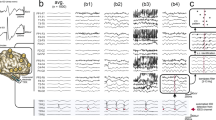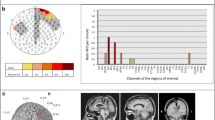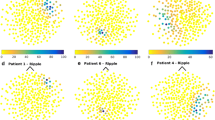Abstract
Since its starting point in 1929, human scalp electroencephalography (EEG) has been routinely interpreted by visual inspection of waveforms using the assumption that the activity at a given electrode is a representation of the activity of the cerebral cortex under it, but such a method has some limitations. In this review, we will discuss three advanced methods to obtain valuable information from scalp EEG in epilepsy using innovative technologies. Authors who had previous publications in the field provided a narrative review. Spike voltage topography of interictal spikes is a potential way to improve non-invasive EEG localization in focal epilepsies. Electrical source imaging is also a complementary technique in localization of the epileptogenic zone in patients who are candidates for epilepsy surgery. Quantitative EEG simplifies the large amount of information in continuous EEG by providing a static graphical display. Scalp electroencephalography has the potential to offer more spatial and temporal information than the traditional way of visual inspection alone in patients with epilepsy. Fortunately, with the help of modern digital EEG equipment and computer-assisted analysis, this information is more accessible.
Similar content being viewed by others
References
Rose S, Ebersole JS (2009) Advances in spike localization with EEG dipole modeling. Clin EEG Neurosci 40:281–287
Asadi-Pooya AA, Asadollahi M, Shimamoto S et al (2016) Spike voltage topography in temporal lobe epilepsy. J Neurol Sci 366:209–212
Do Marcolino C, Baulac M, Samson-Dollfus D (1994) Topographic analysis of interictal spikes in the presurgical evaluation of severe partial epilepsy. Neurophysiol Clin 24:20–34 Article in French; abstract was available
Ebersole JS, Wade PB (1990) Spike voltage topography and equivalent dipole localization in complex partial epilepsy. Brain Topogr 3:21–34
Ebersole JS, Wade PB (1991) Spike voltage topography identifies two types of frontotemporal epileptic foci. Neurology 41:1425–1433
Boon P, D'Havé M (1995) Interictal and ictal dipole modelling in patients with refractory partial epilepsy. Acta Neurol Scand 92:7–18
Boon P, D’Have M, Adam C et al (1996) Dipole modeling in epilepsy surgery candidates. Epilepsia 38:208–218
Cuffin BN (1996) EEG localization accuracy improvements using realistically shaped head models. IEEE Trans Biomed Eng 43:299–303
Roth BJ, Ko D, von Albertini-Carletti IR et al (1997) Dipole localization in patients with epilepsy using the realistically shaped head model. Electroencephalogr Clin Neurophysiol 102:159–166
Kaiboriboon K, Lüders HO, Hamaneh M et al (2012) EEG source imaging in epilepsy--practicalities and pitfalls. Nat Rev Neurol 8(9):498–507
Boon P, D’Havé M, Vanrumste B et al (2002) Ictal source localization in presurgical patients with refractory epilepsy. J Clin Neurophysiol 19(5):461–468
Nemtsas P, Birot G, Pittau F et al (2017) Source localization of ictal epileptic activity based on high-density scalp EEG data. Epilepsia 58(6):1027–1036
Wennberg R, Cheyne D (2014) EEG source imaging of anterior temporal lobe spikes: validity and reliability. Clin Neurophysiol 125(5):886–902
Abdallah C, Maillard LG, Rikir E et al (2017) Localizing value of electrical source imaging: frontal lobe, malformations of cortical development and negative MRI related epilepsies are the best candidates. Neuroimage Clin 16:319–329
Brodbeck V, Spinelli L, Lascano AM, et al. Electroencephalographic source imaging: a prospective study of 52 operated epileptic patients. Brain 2011; 134 (Pt 10): 2887–2897.
Mouthaan BE, Rados M, Barsi P et al (2016) Current use of imaging and electromagnetic source localization procedures in epilepsy surgery centers across Europe. Epilepsia 57(5):770–776
Swisher CB, White CR, Mace BE et al (2015) Diagnostic accuracy of electrographic seizure detection by neurophysiologists and non-neurophysiologists in the adult ICU using a panel of quantitative EEG trends. J Clin Neurophysiol 32(4):324–330
Moura LMVR, Shafi MM, Ng M et al (2014) Spectrogram screening of adult EEGs is sensitive and efficient. Neurology. 83(1):56–64
Abend NS, Dlugos D, Herman S (2008) Neonatal seizure detection using multichannel display of envelope trend. Epilepsia 49(2):349–352
Akman CI, Micic V, Thompson A et al (2011) Seizure detection using digital trend analysis: factors affecting utility. Epilepsy Res 93(1):66–72
Dericioglu N, Yetim E, Bas DF et al (2015) Non-expert use of quantitative EEG displays for seizure identification in the adult neuro-intensive care unit. Epilepsy Res 109:48–56
Haider HA, Esteller R, Hahn CD et al (2016) Sensitivity of quantitative EEG for seizure identification in the intensive care unit. Neurology. 87(9):935–944
Pensirikul AD, Beslow LA, Kessler SK et al (2013) Density spectral array for seizure identification in critically ill children. J Clin Neurophysiol 30(4):371–375
Shah DK, Mackay MT, Lavery S et al (2008) Accuracy of bedside electroencephalographic monitoring in comparison with simultaneous continuous conventional electroencephalography for seizure detection in term infants. Pediatrics. 121(6):1146–1154
Stewart CP, Otsubo H, Ochi A et al (2010) Seizure identification in the ICU using quantitative EEG displays. Neurology. 75(17):1501–1508
Du Pont-Thibodeau G, Sanchez SM, Jawad AF et al (2017) Seizure detection by critical care providers using amplitude-integrated electroencephalography and color density spectral array in pediatric cardiac arrest patients. Pediatr Crit Care Med 18(4):363–369
Sarkis RA, Lee JW (2013) Quantitative EEG in hospital encephalopathy: review and microstate analysis. J Clin Neurophysiol 30(5):526–530
Cozac VV, Gschwandtner U, Hatz F et al (2016) Quantitative EEG and cognitive decline in Parkinson’s disease. Parkinsons Dis 2016:9060649
Puskás S, Kozák N, Sulina D et al (2017) Quantitative EEG in obstructive sleep apnea syndrome: a review of the literature. Rev Neurosci 28(3):265–270
Schirrmeister RT, Springenberg JT, Fiederer LDJ et al (2017) Deep learning with convolutional neural networks for EEG decoding and visualization. Hum Brain Mapp 38(11):5391–5420
Iakovidou ND (2017) Graph theory at the service of electroencephalograms. Brain Connect 7(3):137–151
Jaiswal AK, Banka H (2018) Epileptic seizure detection in EEG signal using machine learning techniques. Australas Phys Eng Sci Med 41(1):81–94
Sharmila A Epilepsy detection from EEG signals: a review. J Med Eng Technol 2018(22):1–13
Jun YH, Eom TH, Kim YH et al (2019) Source localization of epileptiform discharges in childhood absence epilepsy using a distributed source model: a standardized, low-resolution, brain electromagnetic tomography (sLORETA) study. Neurol Sci. https://doi.org/10.1007/s10072-019-03751-4 Epub ahead of print
Gao J, Wu M, Wu Y, Liu P (2019) Emotional consciousness preserved in patients with disorders of consciousness? Neurol Sci. https://doi.org/10.1007/s10072-019-03848-w Epub ahead of print
Comi G, Leocani L (1999) Neurophysiological imaging techniques in dementia. Ital J Neurol Sci 20(5 Suppl):S265–S269
Acknowledgments
This review was presented at the 1st International Qatar Epilepsy School in November 2018 by the authors. We thank Hamad Medical Corporation for supporting this event.
Author information
Authors and Affiliations
Contributions
All authors were involved in the conception, design, review process, and preparation of the manuscript. All have approved this final version and all authors agree to be accountable for all aspects of the work.
Corresponding author
Ethics declarations
Conflict of interest
Ali A. Asadi-Pooya, M.D., consultant: LLC and UCB Pharma; Honorarium: Cobel Daru; Royalty: Oxford University Press (Book publication). Paul Boon, M.D., has received consultancy and speaker fees from UCB Pharma, LivaNova, Medtronic, and Eisai.
Hiba A. Haider M.D., Royalties: Uptodate Inc., Demos Publishing. Others, none.
Additional information
Publisher’s note
Springer Nature remains neutral with regard to jurisdictional claims in published maps and institutional affiliations.
Rights and permissions
About this article
Cite this article
Mesraoua, B., Deleu, D., Al Hail, H. et al. Electroencephalography in epilepsy: look for what could be beyond the visual inspection. Neurol Sci 40, 2287–2291 (2019). https://doi.org/10.1007/s10072-019-04026-8
Received:
Accepted:
Published:
Issue Date:
DOI: https://doi.org/10.1007/s10072-019-04026-8




